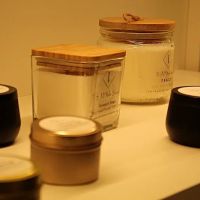How to Avoid Soot Build-Up While Burning Scented Candles
- 1. Introduction to Soot in Scented Candles
- 2. What Causes Soot Build-Up in Scented Candles?
- 3. How to Prevent Soot Build-Up When Burning Scented Candles
- 4. The Role of Candle Quality in Soot Production
- 5. Choosing the Right Wick for Soot-Free Candles
- 6. Tips for Lighting Candles Properly to Minimize Soot
- 7. Candle Maintenance for a Cleaner Burn
- 8. Real-Life Examples of Effective Soot Prevention
1. Introduction to Soot in Scented Candles
Soot is a common byproduct when burning candles, and it can accumulate on walls, furniture, and even on the candle itself. While soot may seem harmless, it can be unsightly and unhealthy when not properly managed. When burning scented candles, it’s crucial to understand how soot is created and how to minimize its build-up to enjoy a cleaner, more enjoyable experience. In this article, we will discuss what causes soot build-up in scented candles, how to prevent it, and practical tips for maintaining your candles to prevent unnecessary messes.
2. What Causes Soot Build-Up in Scented Candles?
Soot build-up in scented candles occurs due to several factors related to the burning process. Understanding these causes can help you reduce soot and enjoy your candles without worrying about residue buildup.
Burning the Candle Improperly
If a candle is not burned properly, it can result in excess soot. One of the main reasons this happens is when the wick is too long or when the candle is lit for too long. The wick needs to be trimmed to about ¼ inch to ensure a clean and even burn.
Quality of the Wax
The type of wax used in the candle can also affect the soot levels. Lower-quality waxes may contain impurities that burn inefficiently and produce more soot. High-quality candles typically burn more cleanly, emitting less soot.
Air Flow
A candle flame can flicker and produce more soot if the candle is in a drafty area. This occurs because the air movement causes the flame to burn unevenly, leading to incomplete combustion. It’s essential to place your candles in areas with minimal air movement to reduce this risk.
id="prevention">3. How to Prevent Soot Build-Up When Burning Scented Candles
To minimize soot while burning scented candles, you can follow a few simple steps. These tips will not only help prevent soot build-up but also prolong the life of your candle and enhance its fragrance release.
Trim the Wick Regularly
One of the most effective ways to reduce soot is by trimming the wick before each use. A wick that’s too long can cause an overly large flame, leading to more soot production. Always trim the wick to about ¼ inch to ensure the flame burns at the right size.
Ensure Proper Ventilation
Burn your candle in a well-ventilated area to prevent the accumulation of soot. A gentle draft helps the candle burn more efficiently and reduces soot. Avoid placing candles near windows or air vents that could cause the flame to flicker.
Allow the Candle to Melt Evenly
When burning your candle, ensure that the entire top layer of wax melts evenly before extinguishing the flame. Uneven melting can lead to tunneling, where the candle burns down the middle, leaving a ring of wax around the edges. This inefficient burn can cause more soot.
4. The Role of Candle Quality in Soot Production
Not all candles are created equal, and the quality of the candle directly impacts the amount of soot produced. When shopping for scented candles, consider the following:
High-Quality Wax
High-quality candles are made with pure waxes such as soy, beeswax, or coconut wax. These waxes burn cleaner and more efficiently than paraffin, which is a less expensive option that tends to produce more soot.
Lead-Free Wicks
It’s essential to choose candles with lead-free wicks. Some candles, particularly older ones, may use wicks with lead cores, which can increase soot production. Always opt for wicks made from cotton or wood for a cleaner burn.
5. Choosing the Right Wick for Soot-Free Candles
The type of wick used in your scented candle can significantly influence the soot it produces. Let’s take a closer look at how to choose the best wick for minimizing soot:
Natural Wicks vs. Synthetic Wicks
Natural wicks, like cotton or wood, tend to burn cleaner than synthetic wicks. Choose candles that use natural materials for wicks to ensure a more soot-free experience.
Wooden Wicks
Wooden wicks are becoming increasingly popular due to their ability to produce a smooth and even burn. They also emit a soft crackling sound as they burn, enhancing the ambiance. Wooden wicks tend to produce less soot compared to traditional cotton wicks, making them a great choice for those sensitive to soot accumulation.
6. Tips for Lighting Candles Properly to Minimize Soot
Properly lighting a candle plays a vital role in preventing soot build-up. Here are some tips to ensure you light your candle in the best way possible:
Light the Candle with a Lighter or Match
Using a match or lighter to light the wick is the best method for ensuring that the flame ignites evenly. Avoid using anything that could cause the flame to flicker, as this can lead to uneven burning and soot production.
Extinguish the Flame Properly
When it's time to extinguish your candle, don’t blow it out, as this can cause wax to splatter and create smoke, leading to soot. Instead, use a candle snuffer to gently put out the flame. This method helps minimize the amount of smoke produced and keeps the wick in good condition.
7. Candle Maintenance for a Cleaner Burn
Maintaining your scented candles properly will help ensure that they burn cleanly and don’t produce excessive soot. Here are some key maintenance tips:
Regularly Clean the Candle Jar
If you notice that your candle jar is becoming dirty with soot, gently wipe it down with a damp cloth to remove any residue. This will help maintain a cleaner burn and prevent soot from collecting on your surfaces.
Store Your Candles Properly
When not in use, store your candles in a cool, dry place away from direct sunlight or heat. This will prevent the wax from melting unevenly and ensure a longer shelf life for your candles.
8. Real-Life Examples of Effective Soot Prevention
Many candle users have shared success stories about reducing soot by making simple changes to how they burn and maintain their candles. For instance, switching to soy-based candles with cotton wicks has helped many users eliminate the soot build-up that they once struggled with when using paraffin candles. Regular wick trimming and proper candle storage have also been proven methods for cleaner burns and less soot.
SEO Title: How to Avoid Soot Build-Up While Burning Scented Candles for a Cleaner Burn
SEO Keywords: Avoid soot build-up, burning scented candles, prevent soot in candles, clean candle burning tips, candle wick maintenance
SEO Description: Learn how to avoid soot build-up while burning scented candles with our expert tips. Discover how to improve your candle burn, prevent soot, and keep your space clean.



0 comments